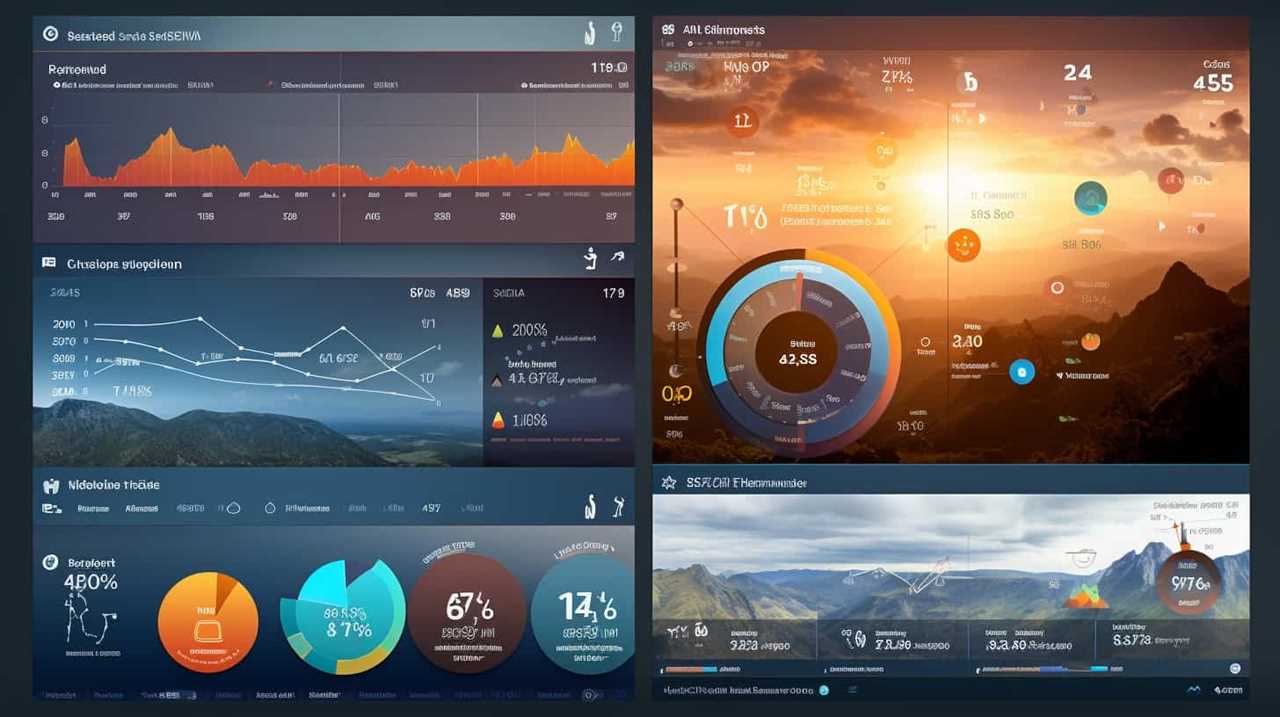Advertising
What Are the Seo Features

We understand your enthusiasm for learning SEO to enhance your website’s visibility. Now, let’s explore the realm of SEO functionalities!
On-Page Optimization, Keyword Research, Content Creation, Technical SEO, Link Building, Mobile Responsiveness, User Experience, and Analytics and Reporting – these are the tools that will help you conquer the search engine rankings.
In this article, we’ll break down each feature and show you how to optimize your website for success.
Get ready to harness the power of SEO!

Key Takeaways
- On-page optimization is crucial for improving website visibility and user experience.
- Keyword research helps identify the right words and phrases to target for better search rankings.
- Content creation and optimization should focus on engaging and informative content that aligns with audience search intent.
- Technical SEO ensures that the website is well-structured and easily accessible for search engines, leading to improved rankings.
On-Page Optimization
The key elements of on-page optimization that can improve our website’s SEO performance include:
- Optimizing meta tags, such as title tags and meta descriptions
- Using relevant keywords in headings and throughout the content
- Optimizing images with alt tags
- Ensuring fast page load times
- Creating a user-friendly and easily navigable website structure.
Keyword Research
To optimize our website’s SEO performance, we need to conduct thorough keyword research.
Keyword research involves identifying the words and phrases that people use when searching for information or products related to our website. This research helps us understand our target audience’s search behavior and allows us to optimize our content accordingly.
One important aspect of keyword research is competitor analysis. By analyzing our competitors’ websites, we can identify the keywords they’re targeting and determine their levels of competition. This information enables us to find gaps and opportunities to target keywords that our competitors may have overlooked.

Another important concept in keyword research is long tail keywords. These are longer, more specific phrases that have lower search volumes but also lower competition. By targeting long tail keywords, we can attract more qualified traffic to our website, as these keywords often indicate higher intent and conversion rates.
Content Creation and Optimization
Our approach to content creation and optimization involves crafting compelling and engaging content that resonates with our target audience and drives organic traffic to our website.
A well-defined content strategy is at the core of our SEO best practices. By conducting thorough keyword research, we identify the topics and themes that are relevant to our audience and align with their search intent.
We then create high-quality content that incorporates these keywords naturally and provides valuable information to our readers. Our content is optimized for search engines, with attention given to on-page factors such as meta tags, headings, and internal linking.

We also prioritize user experience, ensuring that our content is easy to read and navigate. By following these content optimization techniques, we’re able to boost our search engine rankings and increase our organic visibility.
Now, let’s delve into the next section about technical SEO.
Technical SEO
Moving on to the next aspect of our SEO strategy, let’s explore the importance of technical SEO.
A well-structured website is crucial for search engine optimization. The website structure refers to how the pages and content are organized, making it easier for search engines to crawl and index your site. A clear and logical structure not only helps search engines understand your website better but also enhances user experience.

Ensuring crawlability is equally important. Crawlability refers to how easily search engines can access and navigate through your website. By optimizing your website’s crawlability, you can ensure that search engines can find and index all your important pages.
Technical SEO focuses on these fundamental aspects to improve your website’s visibility and overall performance in search engine rankings.
Link Building
We will now delve into the importance of link building as the next aspect of our SEO strategy.
Link building plays a crucial role in improving our website’s visibility and ranking in search engine results.

Here are four reasons why link building is essential:
- Increased website authority: When high-quality websites link to our site, it signals to search engines that our content is valuable and trustworthy.
- Improved organic rankings: Backlinks from reputable sources can boost our website’s visibility in search engine results pages.
- Enhanced brand exposure: Guest blogging allows us to showcase our expertise and reach a wider audience, increasing brand awareness.
- Social media marketing: Building links through social media platforms can drive traffic to our website and improve our online presence.
Mobile Responsiveness
To further enhance our SEO strategy, let’s now explore the significance of mobile responsiveness. In today’s digital landscape, having a mobile-friendly website is no longer an option, but a necessity. With the increasing number of users accessing the internet through their smartphones and tablets, optimizing your website for mobile design and cross-platform compatibility is crucial.
Mobile responsiveness refers to the ability of a website to adapt and provide a seamless user experience across different devices and screen sizes. It ensures that your website looks and functions well on smartphones, tablets, and desktop computers alike. Neglecting mobile responsiveness can lead to a poor user experience, high bounce rates, and ultimately, a negative impact on your SEO rankings.
Here is a table showcasing the benefits of mobile responsiveness:

| Benefits of Mobile Responsiveness |
|---|
| Improved user experience |
| Higher search engine rankings |
| Increased mobile traffic |
| Reduced bounce rates |
| Enhanced brand reputation |
User Experience
A crucial aspect of SEO features is ensuring a seamless user experience for all website visitors. When it comes to user experience, there are several key factors to consider:
- Improving site navigation: Easy navigation helps users find what they’re looking for quickly, reducing bounce rates and increasing engagement.
- A/B testing for UX: Testing different versions of your website allows you to identify the most user-friendly design and layout.
- Responsive design: With a growing number of users accessing websites on mobile devices, it’s important to have a responsive design that adapts to different screen sizes.
- Page loading speed: Slow loading times can frustrate users and drive them away. Optimizing page speed is crucial for a positive user experience.
Analytics and Reporting
When it comes to SEO, analytics and reporting are crucial for tracking website performance and making data-driven decisions.
By analyzing key metrics such as organic traffic, bounce rate, and conversion rates, we can gain insights into the effectiveness of our SEO strategies.
Armed with this information, we can then make informed decisions to optimize our website and improve our search rankings.

Tracking Website Performance
Our website’s performance can be effectively measured and analyzed through the use of analytics and reporting. By tracking various metrics, we can gain valuable insights into the effectiveness of our SEO efforts and make data-driven decisions to improve our website’s performance.
Here are some key aspects to consider when tracking website performance:
- Website speed: Analyzing the loading speed of our website is crucial as it directly impacts user experience and search engine rankings.
- Conversion optimization: Monitoring conversion rates helps us understand how well our website is converting visitors into customers or leads.
- Traffic sources: Examining the sources of our website traffic allows us to identify which channels are driving the most visitors and adjust our marketing strategies accordingly.
- User behavior: Tracking user behavior metrics, such as bounce rate and time spent on site, enables us to pinpoint areas for improvement and enhance user engagement.
Data-Driven Decision Making
To make informed decisions, we rely on analytics and reporting to guide our data-driven approach to SEO. Data analysis and performance metrics play a crucial role in understanding the effectiveness of our SEO efforts and identifying areas for improvement. By analyzing data, we can uncover valuable insights into user behavior, keyword performance, and website traffic. This allows us to make data-driven decisions that can optimize our SEO strategy and drive better results.
| Data Analysis | Performance Metrics |
|---|---|
| Keyword research | Organic search traffic |
| Competitor analysis | Conversion rate |
| Website performance | Bounce rate |
Through comprehensive data analysis, we can gain valuable insights that inform our SEO strategy and help us achieve our goals. By monitoring key performance metrics, we can track the effectiveness of our efforts and make informed decisions based on data, ultimately improving our SEO performance.

Improving Search Rankings
By analyzing data and utilizing analytics, we can improve search rankings through effective SEO strategies and reporting. Here are four key ways to enhance search rankings:
- Backlink Strategy: Building a strong network of high-quality backlinks helps search engines recognize the credibility and relevance of your website.
- Local SEO Optimization: Optimizing your website for local search queries can improve visibility in local search results and attract more targeted traffic.
- Keyword Research: Conducting thorough keyword research enables you to identify relevant keywords and incorporate them strategically throughout your website content.
- Content Quality: Creating high-quality, informative, and engaging content not only attracts visitors but also encourages them to spend more time on your site, which can positively impact search rankings.
Frequently Asked Questions
How Long Does It Take to See Results From SEO Efforts?
It takes time to see results from SEO efforts. The timeframe for SEO results depends on various factors such as website optimization, content quality, and competition. Measuring SEO success is crucial for tracking progress and making improvements.
What Are the Most Common Mistakes to Avoid in On-Page Optimization?
In on-page optimization, we must avoid common mistakes to ensure success. By following these tips, we can optimize our website effectively and improve our SEO rankings.
How Can I Determine Which Keywords Are Best for My Website?
To determine the best keywords for our website, we need to conduct thorough keyword research. By analyzing search volume, competition, and relevance, we can optimize our website content for maximum SEO impact.

What Are Some Effective Strategies for Building High-Quality Backlinks?
To build high-quality backlinks, we recommend guest posting and influencer outreach. These strategies involve creating valuable content and reaching out to influential individuals in your industry to share it.
How Important Is Mobile Responsiveness for Seo?
Mobile usability is crucial for SEO rankings. It affects how well our website performs on mobile devices and impacts user experience. Ensuring our site is mobile-friendly is essential to maintain high SEO rankings.
Conclusion
In conclusion, SEO features play a crucial role in improving a website’s visibility and rankings on search engines.
By implementing on-page optimization, conducting thorough keyword research, creating high-quality content, optimizing technical aspects, building relevant links, ensuring mobile responsiveness, and enhancing user experience, websites can significantly boost their online presence.

Although some may argue that SEO is time-consuming, the long-term benefits of increased organic traffic and higher conversion rates make it a worthwhile investment for any business.
Advertising
How Do I Pass an Seo Interview

The famous quote ‘knowledge is power’ is widely recognized. This rings especially true when it comes to excelling in an SEO interview.
We know you’re eager to liberate yourself from the anxiety of job hunting and impress potential employers with your SEO expertise. That’s why we’re here to share essential concepts, effective strategies, and expert tips to help you nail that interview and secure your dream SEO job.
Let’s dive in and unleash your SEO potential!
Key Takeaways
- Understanding SEO best practices, core components, and the importance of SEO tools and analytics
- Advanced keyword analysis, understanding keyword intent, and targeting high-potential keywords
- Content creation, conducting SEO audits, and optimizing factors like page load speed and mobile-friendliness
- Mastering technical SEO by focusing on website architecture, site visibility, and mobile optimization
Essential SEO Concepts
In this section, we’ll explore the fundamental principles and core components of SEO. Understanding SEO best practices is essential for achieving success in digital marketing.

SEO tools and analytics play a crucial role in optimizing our website’s performance and improving our online visibility. By utilizing these tools, we can analyze important data such as keyword rankings, website traffic, and user behavior. This valuable information allows us to make data-driven decisions and continuously improve our SEO strategies.
Implementing SEO best practices and leveraging SEO tools and analytics is key to staying ahead in the competitive online landscape.
Now that we’ve covered the essential concepts of SEO, let’s dive into the next section, which will focus on effective keyword research strategies.
Effective Keyword Research Strategies
Now let’s explore effective keyword research strategies to further enhance our SEO efforts and drive targeted organic traffic to our website.

One of the key strategies is advanced keyword analysis. This involves going beyond basic keyword research and delving deeper into understanding the intent behind the keywords. By analyzing search volume, competition, and relevance, we can identify high-potential keywords that will bring in the most relevant traffic.
Additionally, long tail keyword targeting is another powerful strategy. Long tail keywords are longer and more specific phrases that have less competition and higher conversion rates. By targeting these niche keywords, we can attract highly qualified visitors who are more likely to convert into customers.
On-Page Optimization Techniques
To continue our discussion on effective SEO strategies, let’s dive into the realm of on-page optimization techniques.
On-page optimization plays a crucial role in improving a website’s visibility and ranking in search engine results pages (SERPs). One key aspect of on-page optimization is content creation. By creating high-quality, relevant, and engaging content, you can attract more organic traffic and keep visitors on your site longer.

Additionally, conducting an SEO audit is essential to identify areas for improvement on your website. This includes analyzing factors such as page load speed, mobile-friendliness, URL structure, and metadata.
Mastering Technical SEO
Continuing our exploration of effective SEO strategies, let’s delve into the realm of mastering technical SEO with a focus on optimizing website performance and structure.
A well-designed website architecture is crucial for search engines to understand and crawl your site effectively. It involves organizing your website’s pages, URLs, and navigation in a logical and user-friendly manner. This can improve your site’s visibility and accessibility, ultimately boosting its search rankings.
Additionally, mobile optimization is essential in today’s digital landscape, as more and more users access the internet through their smartphones. Ensuring that your website is responsive and mobile-friendly won’t only enhance the user experience but also align with search engines’ preferences, leading to higher rankings.

Nailing SEO Interview Questions
Let’s tackle SEO interview questions head-on to ensure we nail them with confidence and expertise.
When preparing for an SEO interview, it’s important to have a solid understanding of the industry and its best practices. One of the most common SEO interview mistakes isn’t being well-prepared. To avoid this, you should familiarize yourself with the latest SEO trends, algorithms, and tools.
Additionally, it’s crucial to have a clear understanding of the core concepts of SEO, such as keyword research, on-page optimization, and link building.
To further enhance your chances of success, practice answering common SEO interview questions and have specific examples ready to demonstrate your skills and knowledge.

Frequently Asked Questions
What Are Some Common Challenges Faced in Implementing SEO Strategies and How Can They Be Overcome?
Implementing SEO strategies can be challenging due to technical issues and competition. However, we can overcome these obstacles by conducting thorough competitor analysis and addressing any technical issues promptly.
How Can Social Media Platforms Be Integrated Into an SEO Strategy?
Social media platforms can be integrated into an SEO strategy by leveraging social media engagement to drive traffic and improve search engine rankings. Content marketing strategies can be used to create and promote valuable content on social media platforms, boosting visibility and engagement.
What Are Some Effective Ways to Measure the Success of an SEO Campaign?
To measure the success of an SEO campaign, we track key performance indicators such as organic traffic, keyword rankings, and conversion rates. These metrics give us valuable insights into the effectiveness of our strategies.
Can You Provide Some Tips for Optimizing Websites for Voice Search?
When optimizing websites for voice search, key considerations include understanding natural language, using long-tail keywords, and optimizing for featured snippets. Voice search optimization strategies involve creating conversational content and improving site speed for a seamless user experience.

How Important Is Link Building in SEO and What Are Some Best Practices for Building High-Quality Backlinks?
Link building is a crucial aspect of SEO. It helps improve our website’s visibility and rankings. Anchor text plays a significant role in link building, and acquiring natural backlinks through quality content and outreach strategies is essential.
Conclusion
In conclusion, mastering the art of SEO is like navigating a vast ocean of information. By understanding essential concepts, conducting effective keyword research, implementing on-page optimization techniques, and mastering technical SEO, you can set sail toward success.
Just like a skilled sailor, your ability to navigate this ever-changing landscape will determine your success in an SEO interview. So, prepare yourself, equip your knowledge, and confidently set sail into the world of SEO.
Advertising
How Do I Get Free Seo Keywords

Are you tired of spending a significant amount of money on SEO keywords? Your search ends here! Discover the methods to acquire SEO keywords without any cost.
In this article, we’ll share the secrets to finding valuable keywords without breaking the bank. By utilizing tools like Google’s Keyword Planner and analyzing competitor keywords, you can optimize your website for search engines without spending a dime.
Get ready to unlock the power of free SEO keywords and set your website free!
Key Takeaways
- Importance of conducting keyword research and utilizing keyword research tools for website optimization
- Benefits of using long-tail keywords for free SEO optimization, including attracting a more relevant audience and improving search engine rankings
- The value of leveraging user-generated content for keyword research, such as maximizing social media engagement and analyzing customer reviews for keyword insights
- The strategic advantage of analyzing competitor keywords and incorporating competitor keyword insights into our SEO strategy, including using tools for competitive analysis and analyzing keyword gaps.
Understanding the Importance of SEO Keywords
Understanding the importance of SEO keywords involves identifying the most relevant and effective terms for optimizing website visibility and attracting organic traffic.

One crucial aspect of SEO optimization is understanding keyword density. Keyword density refers to the percentage of times a specific keyword appears on a web page compared to the total number of words. It’s essential to strike the right balance between using keywords enough to boost search engine rankings, but not so much that it appears unnatural or spammy.
Another factor that plays a significant role in boosting SEO rankings is the use of meta tags. Meta tags are snippets of HTML code that provide information about a web page’s content to search engines. They include title tags, meta descriptions, and meta keywords.
By optimizing these meta tags with relevant keywords, you can improve your website’s visibility and attract more organic traffic.
Understanding keyword density and utilizing meta tags effectively are key elements in achieving successful SEO optimization.

Utilizing Google’s Keyword Planner Tool
To further optimize website visibility and attract organic traffic, we can utilize Google’s Keyword Planner Tool. This tool is a powerful resource that enables us to conduct keyword research and find relevant keywords for our website.
By identifying the right keywords, we can improve our website’s ranking on search engine results pages and attract more visitors.
In addition to Google’s Keyword Planner Tool, there are other alternative keyword research tools available that can provide valuable insights. These tools can help us find keywords that might be overlooked by competitors, giving us a competitive edge.
Once we’ve identified our target keywords, it’s important to maximize keyword density in our website content. This means incorporating the keywords naturally and strategically throughout our website to increase its visibility and relevance to search engines.

Exploring Long-Tail Keywords for Free SEO Optimization
After utilizing Google’s Keyword Planner Tool, we can now delve into exploring long-tail keywords for free SEO optimization. Long-tail keywords are longer and more specific keyword phrases that are often less competitive but highly targeted. They can help you attract a more relevant audience and improve your search engine rankings.
When conducting keyword research, it’s important to consider the intent of your target audience. By understanding their needs and preferences, you can identify long-tail keywords that align with their search queries. Here’s a table highlighting some keyword research techniques and long-tail keyword strategies:
| Keyword Research Techniques | Long-Tail Keyword Strategies |
|---|---|
| Analyzing competitor keywords | Using question-based keywords |
| Exploring related searches | Incorporating location-specific keywords |
| Conducting customer surveys | Targeting niche-specific keywords |
Leveraging User-Generated Content for Keyword Research
We can further enhance our keyword research by leveraging user-generated content. One effective way to do this is by maximizing social media engagement for keyword discovery.
By actively engaging with our audience on social media platforms, we can gather valuable insights into the words and phrases they use when discussing our products or services.

Additionally, harnessing the power of customer reviews can provide us with valuable keyword insights. By analyzing the language used in these reviews, we can identify recurring keywords that are relevant to our business.
This user-generated content can give us a deeper understanding of how our target audience thinks and speaks about our offerings. By incorporating these insights into our keyword research, we can optimize our SEO strategy to better meet our audience’s needs.
Now, let’s dive into the next section about analyzing competitor keywords for free SEO insights.
Analyzing Competitor Keywords for Free SEO Insights
Continuing our exploration of keyword research, let’s now delve into the world of analyzing competitor keywords to gain valuable SEO insights. When it comes to optimizing our website for search engines, understanding what keywords our competitors are ranking for can provide us with a strategic advantage.

Here are four steps to help us analyze competitor keywords effectively:
- Identify top ranking competitor keywords: Start by identifying our main competitors in the industry and then analyze their websites to identify the keywords they’re ranking for.
- Use SEO keyword research tools for competitive analysis: Utilize tools like SEMrush or Ahrefs to gather data on our competitors’ keyword rankings, search volume, and competition level.
- Analyze keyword gaps: Compare our own keyword rankings to those of our competitors to identify any keyword gaps we can take advantage of.
- Study competitor content: Analyze our competitors’ content to understand how they’re using keywords effectively and incorporate those strategies into our own content.
Frequently Asked Questions
What Are Some Common Mistakes to Avoid When Conducting Keyword Research for SEO Optimization?
When conducting keyword research for SEO optimization, it’s important to avoid common mistakes. By using effective long tail keyword identification techniques, we can ensure accurate and targeted results that will boost our website’s visibility.
How Can I Identify the Most Effective Long-Tail Keywords for My Website?
To identify the most effective long-tail keywords for your website, consider best practices for using long tail keywords in content marketing. Additionally, track the performance of long tail keywords in SEO campaigns to optimize your strategy.
Are There Any Alternative Keyword Research Tools Besides Google’s Keyword Planner?
There are alternative keyword research tools besides Google’s Keyword Planner. We can explore the best practices for using them and optimize SEO keywords for voice search. Let’s liberate our SEO strategies!

How Can I Optimize User-Generated Content to Target Specific SEO Keywords?
To optimize user-generated content for targeting specific SEO keywords, we can follow a few steps. First, research and identify the keywords relevant to your content. Then, incorporate these keywords naturally into the user-generated content to enhance its SEO performance.
What Are Some Strategies for Staying Updated on Competitor Keywords in Order to Gain an Edge in Seo?
To gain an edge in SEO, we stay updated on competitor keywords through thorough competitor analysis. This allows us to develop an effective SEO strategy that liberates us from relying solely on free SEO keywords.
Conclusion
In the vast world of SEO, finding free keywords can feel like searching for buried treasure. But fear not! By understanding the importance of keywords, utilizing tools like Google’s Keyword Planner, exploring long-tail keywords, leveraging user-generated content, and analyzing competitor keywords, you can unlock the hidden gems that will boost your website’s visibility.
So, put on your SEO detective hat and start uncovering those valuable keywords, turning your website into a shining star in the vast online universe.

Happy hunting!
Advertising
How Can I Practice Seo for Free

Are you tired of shelling out a lot of money on SEO tools and services? Well, we have some exciting news for you! In this article, we will share our tips on how to implement SEO without spending a dime.
Yes, you heard that right – free! Get ready to unlock the secrets of keyword research, on-page optimization, content creation, building high-quality backlinks, and monitoring SEO performance.
Say goodbye to expensive tools and hello to liberation! Let’s dive in and revolutionize your SEO game, together.
Key Takeaways
- Conduct thorough keyword research using free keyword research tools to identify popular and relevant topics.
- Incorporate relevant keywords naturally throughout the content to optimize website visibility in search results.
- Implement on-page optimization techniques such as optimizing meta tags, page titles, and on-page elements like headings and keyword usage.
- Build high-quality backlinks through guest posting on niche websites and sharing website content on social bookmarking sites to increase visibility and improve search engine rankings.
Keyword Research
When practicing SEO for free, we begin by conducting keyword research to identify the most relevant and valuable terms to target for website optimization. Competitor analysis plays a vital role in this process. By analyzing our competitors’ websites, we can gain insights into the keywords they’re targeting and identify potential gaps or opportunities.

Additionally, we focus on long tail keywords, which are more specific and have lower competition. These keywords allow us to attract highly targeted traffic and increase our chances of ranking higher in search engine results.
By incorporating competitor analysis and long tail keywords into our keyword research strategy, we can optimize our website effectively and attract the right audience.
With this foundation in place, we can now move on to the next step: on-page optimization.
On-Page Optimization
To optimize our website for search engines without spending any money, we focus on improving our on-page elements. This includes optimizing our meta tags and page titles. Meta tags provide information about the content of a webpage to search engines, while page titles help search engines understand the topic of the page. By using relevant keywords in our meta tags and page titles, we can improve our website’s visibility in search results.

Another important aspect of on-page optimization is image optimization. This involves optimizing the images on our website to make them more search engine-friendly. We can achieve this by using descriptive filenames, alt tags, and optimizing the image size and format. By implementing these image optimization techniques, we can enhance our website’s overall SEO performance and attract more organic traffic.
Content Creation and Optimization
For content creation and optimization, we prioritize the creation and optimization of high-quality and relevant content on our website. This is essential for effective content promotion and to ensure that our website ranks well in search engine results.
To achieve this, we follow a few key strategies:
- Conducting thorough keyword research to identify popular and relevant topics to write about.
- Creating compelling, informative, and engaging content that appeals to our target audience.
- Incorporating relevant keywords naturally throughout the content to improve its visibility to search engines.
- Using SEO friendly website design techniques, such as optimizing page load speed and ensuring mobile responsiveness.
- Implementing proper on-page optimization techniques, such as meta tags and header tags, to enhance the visibility of our content.
Building High-Quality Backlinks
As we delve into the topic of practicing SEO for free, one crucial aspect to explore is the process of building high-quality backlinks. Backlinks are links from other websites to your own, and they play a significant role in improving your website’s search engine ranking.

One effective way to build high-quality backlinks is through guest posting. By writing valuable content for other websites in your niche, you can include a link back to your own site. This not only helps you gain exposure to a new audience but also establishes your website as a reliable source of information.
Another method is through social bookmarking, where you share your website’s content on social bookmarking sites. This helps increase visibility and attract more visitors to your site.
Moving forward, let’s now explore the next step in practicing SEO for free – monitoring and analyzing SEO performance.
Monitoring and Analyzing SEO Performance
Now, let’s delve into how we can effectively monitor and analyze the performance of our SEO efforts. To ensure that our SEO strategies are yielding the desired results, it’s crucial to regularly monitor and analyze our performance.

Here are some key steps to help us in this process:
- Implement competitor analysis: By studying our competitors’ SEO strategies, we can identify areas for improvement and stay ahead in the game.
- Utilize local SEO strategies: Targeting local keywords and optimizing our website for local search can help us attract relevant and high-quality traffic.
- Track keyword rankings: Monitoring our keyword rankings allows us to evaluate the effectiveness of our SEO efforts and make necessary adjustments.
- Analyze website traffic: By analyzing website traffic, we can identify which sources are driving the most visitors to our site and optimize accordingly.
- Monitor conversion rates: Tracking conversion rates helps us measure the success of our SEO campaigns in terms of generating leads or sales.
Frequently Asked Questions
What Are Some Common Mistakes to Avoid When Conducting Keyword Research?
When conducting keyword research, we need to be aware of common mistakes. By understanding these mistakes, we can avoid them and improve the effectiveness of our SEO strategies.
Are There Any Specific Strategies or Techniques to Optimize Images for On-Page Seo?
When it comes to optimizing images for on-page SEO, we have found that compressing images without losing quality and using descriptive alt tags are two effective techniques. These best practices can greatly improve your website’s SEO.
How Can I Ensure That My Content Is Engaging and Relevant to Both Search Engines and Users?
Creating captivating meta descriptions and improving user experience are key to ensuring that our content is engaging and relevant to both search engines and users. It’s essential for better SEO rankings.

What Are Some Effective Ways to Acquire High-Quality Backlinks Organically?
To acquire high-quality backlinks organically, we recommend guest blogging and influencer collaborations. These strategies allow us to build relationships and gain valuable exposure, boosting our website’s credibility and visibility in search engines.
Is There a Recommended Frequency for Monitoring and Analyzing SEO Performance?
There is a recommended frequency for reporting and analyzing SEO performance. Regular analysis allows us to stay on top of our SEO efforts, identify areas for improvement, and make data-driven decisions.
Conclusion
In conclusion, practicing SEO for free isn’t only possible but also crucial for improving website visibility and driving organic traffic.
By focusing on keyword research, optimizing on-page elements, creating high-quality content, and building strong backlinks, you can greatly enhance your SEO performance.

So, don’t miss out on this golden opportunity to skyrocket your website’s rankings and dominate the search engine results.
Start implementing these strategies today, and watch your online presence soar like a rocket in the digital universe!
-

 Holistic SEO3 months ago
Holistic SEO3 months agoHolistic Local SEO Tactics for Small Businesses
-

 Holistic SEO3 months ago
Holistic SEO3 months agoKeyword Research (SEO) for Tattoo Artists
-

 Holistic SEO3 months ago
Holistic SEO3 months agoHow to Establish Dominance in SEO through Topical Authority
-

 Learning Center3 months ago
Learning Center3 months ago52 Niches with Good Crossover Potential Explored
-

 Learning Center3 months ago
Learning Center3 months agoThe Future of SEO: Leveraging the Google Search Generative Experience
-

 Holistic SEO3 months ago
Holistic SEO3 months agoHolistic SEO Food Blogger
-

 Keyword Research3 months ago
Keyword Research3 months agoMastering SEO: How to Analyze Keyword Results and Find Easy Keywords
-

 Technical SEO3 months ago
Technical SEO3 months agoUnlock Your Site’s Potential with a Comprehensive Website Audit



















